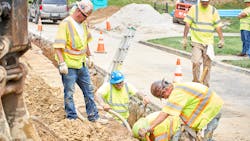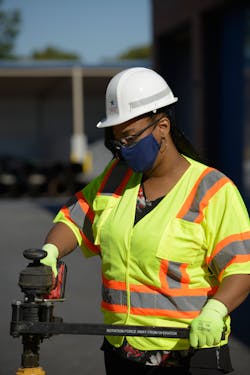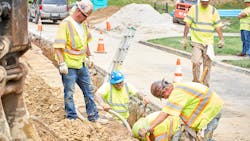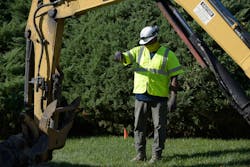As the water industry takes on new challenges associated with emerging contaminants, climate variability, water scarcity and changing customer needs (just to name a few), more pressure is being applied to our nation’s rapidly aging and underfunded water and wastewater infrastructure. A century ago, with no modern regulatory standards in place, the United States’ water infrastructure system was built primarily to serve city centers and rapidly growing industrial customer demands.
Today, some of the same infrastructure is used to meet the water and sanitation needs of a very different customer base with vastly expanded regulatory requirements. The population has nearly tripled over the last century, population centers have spread out, and customer water needs and usage patterns have changed dramatically. Additionally, storms and other natural disasters have intensified and strike with increasing frequency, especially over the last few decades. As a result of these changes, many outdated water and wastewater systems across the nation are struggling to keep up.
Despite various efforts to address this issue nationwide, the industry continues to lag overall in terms of the investment needed to improve America’s aging water infrastructure. In fact, the gap between annual spending and funding needed to fix our country’s infrastructure has reached $81 billion and continues to grow. If left unaddressed, the implications could be detrimental to the people, businesses, industries and overall financial stability of our country.
Even if our infrastructure wasn’t past its prime, there would still be challenges under the current circumstances. The nation’s water customers are served by more than 50,000 drinking water systems that distribute 39 billion gallons of potable water daily to U.S. homes and businesses. In addition, approximately 15,000 wastewater utilities serve 75 percent of the U.S. population, collecting and treating approximately 32 billion gallons of wastewater daily before returning it to the environment. This disparate system of water and wastewater utilities makes it difficult to establish and carry out a unified national strategy to address the most pressing challenges facing our water infrastructure needs.
However, there are many opportunities for water utility experts to be a part of the solution. And, for a truly better tomorrow, they all must start with a unified goal of increasing investment in the future of water infrastructure.
The Cost of Not Investing
The aging water infrastructure in the U.S. is not just a water industry issue, it is a national issue. If utilities keep under-investing in water infrastructure, these systems will continue to deteriorate, leading directly to more main breaks, flooding, service interruptions, unsatisfactory water quality, and negatively impacting every person and business that relies on them for safe and reliable service.
Changing Now, For a Better Future
Investment in water infrastructure at every level is crucial to protecting the financial stability and public health of generations to come. So, just as a growing deficit in funding would incite ruin, appropriate and strategic investment can bring prosperity. The ASCE and the Value of Water Campaign’s study predicts that improving our water infrastructure system through targeted investment would raise the U.S. GDP by $4.5 trillion, create 800,000 jobs, and increase disposable income by over $2,000 per household.
At American Water, we are replacing aging pipes and upgrading our systems at a significantly higher rate than the industry average. While nationally the renewal cycle for water and wastewater pipes is approximately 200 years, American Water is on pace to nearly double that renewal rate by 2025. Over the next ten years, by investing approximately $20 to $25 billion through targeted capital investment to replace and upgrade pipes, pumps, treatment and storage, we will continue to address the most significant risks that could adversely affect our overarching goal to provide safe and reliable water and wastewater services.
- Balance infrastructure needs with customer affordability: When carried out carefully and strategically using a risk-based approach, making capital investments in our water infrastructure can result in major improvements without compromising customer affordability.
- Consider operating and maintenance costs: Be sure to consider improved reliability and efficiency as an outcome of your capital investment strategy will benefit operating and maintenance costs.
- Factor in climate variability: Don’t underestimate the risks of climate variability or the benefits of making your water utility resilient when shaping your investment strategies. The risks of climate variability are increasing every year, and utility professionals shouldn’t be relying exclusively on historical data to make investment decisions or plan for disaster events. Making your utility more resilient through both hardening of your assets and implementing emergency planning and training will benefit both your utility’s bottom line and the customers that live in the communities you serve.
- Account for water scarcity: Varying from location to location with disparate impacts, water scarcity is one of the major risks facing the industry and should be considered in approaching a solution for broader water infrastructure challenges. In fact, a solution to one issue can be a solution to both. Encouraging conservation lessens the pressure on pipes, and fixing infrastructure can reduce water wasted from leaks and breaks.
With the help of our water utilities, the U.S. can make positive steps to begin to address our infrastructure challenges. Together, we can align on a strategy of targeted capital investment directed at fixing our water and wastewater infrastructure. This effort, led by utility experts, will need to include support from local, state, and federal government and all industries and commercial business that rely on water services to survive. By acknowledging the current state of our water and wastewater systems, investing accordingly and educating the broader business community about the positive impacts of water infrastructure investment, we can make an impact and improve our communities across the country. WW
References
1. The Economic Benefits of Investing in Water Infrastructure: How a Failure to Act Would Affect the U.S. Economic Recovery. Washington: American Society of Civil Engineers and Value of Water Campaign, 2020. Accessed January 27, 2021.
About the Author: David Choate is VP of Engineering with American Water. In his role, he is responsible for strategic planning, management, and delivery of American Water’s utility capital program of approximately $1.6 billion annually, as well as leading the corporate engineering department to provide support for more than 450 water and wastewater systems across 16 regulated state subsidiary companies and market-based businesses. He joined American Water in 2005, and has 26 years of experience in water and wastewater utility related fields. He s a licensed professional engineer in Maryland and Virginia.
About the Author

David Choate
David Choate is VP of Engineering with American Water. In his role, he is responsible for strategic planning, management, and delivery of American Water’s utility capital program of approximately $1.6 billion annually, as well as leading the corporate engineering department to provide support for more than 450 water and wastewater systems across 16 regulated state subsidiary companies and market-based businesses. He joined American Water in 2005, and has 26 years of experience in water and wastewater utility related fields. Choate is a licensed professional engineer in Maryland and Virginia.



